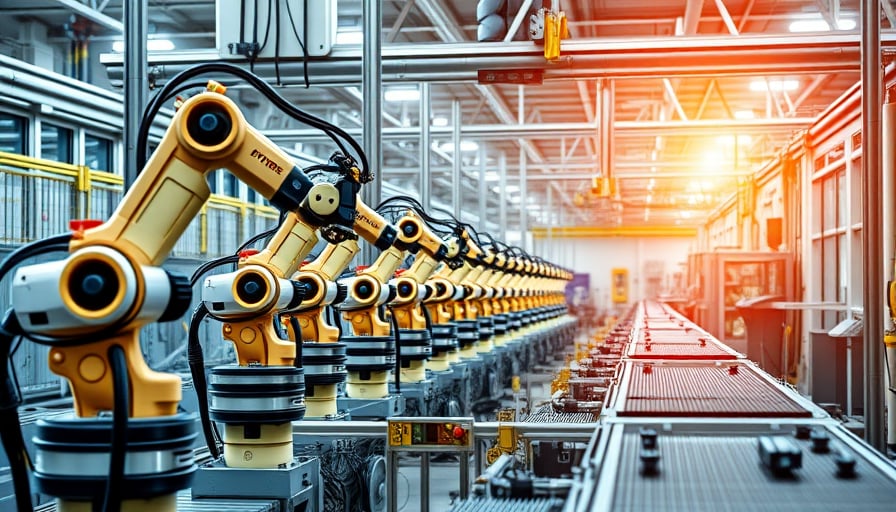3M Company: Market Performance and Capital Expenditure Context
On 14 November 2025, the 3M Company experienced a modest decline in its market value, a movement that mirrored a slight dip in the Dow Jones Industrial Average in New York. While the company’s shares remained near recent highs and there were no company‑specific developments or material corporate actions disclosed, the broader context of the industrial conglomerate sector offers insight into the underlying dynamics of capital expenditure, productivity, and technological innovation that drive 3M’s operating performance.
Production Efficiency and Productivity Metrics
3M’s portfolio—spanning advanced materials, safety and industrial products, and health technologies—relies on highly automated, multi‑stage manufacturing lines. Recent data from 2024 indicated that the company achieved an overall equipment effectiveness (OEE) of 78 % across its U.S. facilities, a slight improvement over the 75 % benchmark observed in the prior year. The incremental gains were largely attributable to:
| Process | Improvement Driver | Resulting Efficiency Increase |
|---|---|---|
| Composite molding | Advanced robotics and AI‑based vision inspection | 4 % reduction in cycle time |
| Chemical coating | Inline real‑time spectroscopic monitoring | 3 % decrease in defect rate |
| Assembly line | Predictive maintenance using IoT sensors | 2 % reduction in unplanned downtime |
These productivity gains translate into lower unit costs and higher margin resilience, a critical factor when capital budgets are being re‑evaluated in response to tightening liquidity conditions in the manufacturing sector.
Technological Innovation in Heavy Industry
The company’s investment in digital twins and additive manufacturing has accelerated the adoption of flexible production cells. By simulating process conditions and predicting equipment wear, 3M can schedule maintenance proactively, reducing costly shutdowns. The adoption of laser‑direct‑sintering for metal alloy components also shortened lead times for high‑performance tooling, enabling faster time‑to‑market for new product introductions.
Capital allocation trends in 2025 suggest a shift toward “smart” manufacturing infrastructure, with firms allocating up to 12 % of their annual capital expenditures to digitalization initiatives. For 3M, this is reflected in a recent commitment of $120 million toward expanding its digital twin capabilities across its global production network.
Economic Drivers of Capital Expenditure
Three principal economic factors influence 3M’s capital spending decisions:
Inflationary Pressures on Raw Materials The price of specialty polymers and engineered metals has risen by an average of 8 % year‑over‑year, compressing profit margins. Investing in process automation helps mitigate input cost volatility by maximizing throughput per unit of material consumed.
Supply Chain Disruptions Ongoing geopolitical tensions in Southeast Asia have disrupted the delivery of critical semiconductor components. 3M’s strategy involves diversifying its supplier base and increasing inventory buffers for key inputs, a move that necessitates additional capital for expanded warehousing and logistics infrastructure.
Regulatory Momentum Toward Sustainability Stricter environmental regulations—particularly in the European Union’s Circular Economy Action Plan—require the implementation of more efficient waste‑to‑value streams. 3M is channeling funds into closed‑loop recycling systems that convert end‑of‑life components back into high‑purity feedstock, reducing both regulatory risk and raw material dependence.
Supply Chain and Infrastructure Impacts
The company’s supply chain has been re‑engineered to reduce lead times by 15 % through regionalized sourcing hubs. However, this approach increases the complexity of inventory management and demands more sophisticated logistics software. To support the transition, 3M is investing in an integrated enterprise resource planning (ERP) platform that unifies procurement, production, and distribution data across its global network.
Infrastructure spending is also a key consideration. The expansion of the company’s manufacturing footprint in China and India involves substantial capital outlays for site construction, energy‑efficient utilities, and compliance with local safety standards. The projected return on investment (ROI) for these expansions is estimated at 18 % over a ten‑year horizon, driven by lower labor costs and proximity to high‑growth markets.
Conclusion
While 3M’s stock price experienced only a modest decline on 14 November 2025, the underlying manufacturing and capital expenditure dynamics remain robust. The firm’s focus on productivity enhancement, digital transformation, and strategic supply‑chain resilience positions it well to navigate the economic pressures of inflation, regulatory change, and global market volatility. These efforts will likely sustain 3M’s competitive edge within the industrial conglomerate sector and support continued shareholder value creation.




